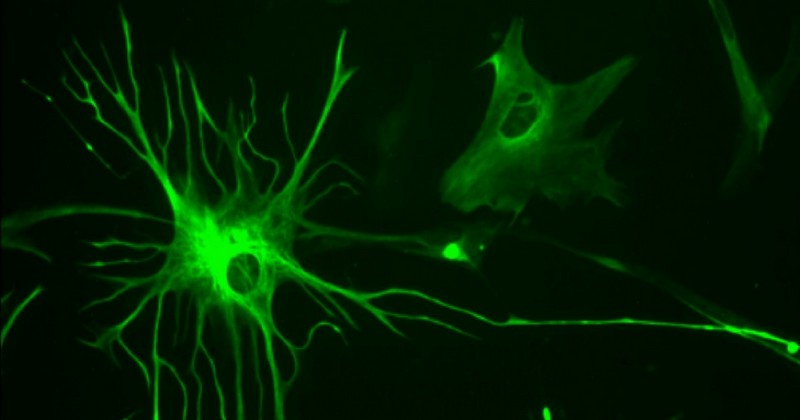Astrocytes: what are the functions of these glial cells?

Glial cells are most abundant in the brain, and this is one of its most important types.
Glial cells are essential for the functioning of the nervous system as they provide structure, nutrients and protection to neurons, in addition to carrying out other relevant tasks.
In this article we will discuss astrocytes, one of the most common types of glia.. We will describe their morphology and main functions and differentiate the three types of astrocyte that have been identified.
What are astrocytes?
Astrocytes are a type of glial cell that is located in the central nervous system, i.e., in the encephalon.that is, in the brain and spinal cord. Like the rest of the glia, astrocytes play supporting roles in relation to neurons, the main cells of the nervous system from a functional point of view.
These glial cells have a shape slightly reminiscent of that of a star.Their name derives from this fact, since the Greek and Latin words "astron" and "astrum" translate as "star" or "celestial body". Such a structure is due to the fact that they have many extensions ("feet") that connect the soma with other nearby cells.
Astrocytes are formed from cells of the ectoderm, the embryonic disc layer.the embryonic disc layer from which the nervous system and epidermis arise, during the early development of the organism. Like most glia, astrocytes arise from undifferentiated cells similar to those that give rise to neurons.
Glial cells or glia
As we know, neurons specialize in the transmission of nerve impulses. They are therefore very efficient in this task, but they need the support of other cell types in order for the nervous system to function properly; this is where glia or neuroglia come in, i.e. the glial cells as a whole, which account for 50% of the nerve mass.
The specific roles of these cells depend on the type of glia we are referring to. In general terms, we can say that they serve mainly to to provide physical and structural support to the neuronsThe specific roles of these glial cells depend on the type of glia to which we refer.
Other particularly relevant glial cells are microglia, which perform defensive and immunological functions in the brain and spinal cord, oligodendrocytes and Schwann cells.which form the myelin sheaths that surround the axons and accelerate neuronal transmission in the central and peripheral nervous system, respectively.
Functions of astrocytes
For a long time it was believed that the function of astrocytes was basically structural: "filling the gaps" left by neurons in the nervous system.
However, research in recent decades has shown that their role, like that of all other glial cells, is much more complex.
1. Nerve structure
Astrocytes, and glia in general, play the important role of providing physical support to neuronsThey also regulate the transmission of electrical impulses. Astrocytes are the most abundant glia in the brain, so their structural role is particularly relevant in this organ.
2. Blood-brain barrier
These glial cells act as intermediaries between neurons and the circulatory system, specifically the Blood vessels.specifically the blood vessels. In this sense, they perform a filtering function, so that they constitute a part of the blood-brain barrier, formed by tightly bound brain endothelial cells.
3. Nutrient supply
The connection of astrocytes with the vascular system allows them to obtain nutrients, such as glucose or lactic acid, from the blood and provide them to the neurons.
4. Phagocytosis and waste disposal
Similarly, astrocytes collect waste products from the neurons and transported into the bloodstream so that they can be eliminated.. In addition, when an injury occurs in the nervous system, the astrocytes move towards it to phagocytose or eliminate the dead neurons, forming scars in the damaged area when they accumulate in it.
5. Glycogen reserve
It is possible that astroglia also have the function of storing glycogen, which serves as an energy reservoir, so that neurons can access these reserves in times of need.
6. Regulation of the extracellular space
Astrocytes help to maintain the ionic balance in the extracellular space; in particular, reverse the excessive accumulation of potassium because they are highly permeable to these molecules.
Astrocyte types
There are three types of astrocyte that are differentiated by the cell lineage from which they originate, i.e. the type of neuroepithelial cells from which they originate. Thus, we can distinguish between fibrous, protoplasmic and radial astrocytes..
1. Fibrous
These astrocytes are located in the white matter of the nervous system, i.e. in areas predominantly formed by myelinated axons. They are characterized by their low number of organelles (cellular subunits with differentiated functions).
2. Protoplasm
Protoplasmacytes contain many organelles and are the most numerous type of astrocyte.. They are mainly located in the gray matter of the brain, which is composed mainly of cell bodies.
3. Radial glia
Radial glia play a decisive role during the cell migration process, as neurons "travel" through the nervous system relying on this type of astrocyte. However, there are also radial glial cells active in adulthood, such as Bergmann cells located in the cerebellum.
Bibliographic references:
- Aragona M, Kotzalidis GD, Puzella A. (2013). The many faces of empathy, between phenomenology and neuroscience.
- D'Amicis, F., Hofer, P. y Rockenhaus, F. (2011). El cerebro automático: la magia del inconsciente.
- Finger, Stanley (2001). Origins of Neuroscience: A History of Explorations into Brain Function (3rd ed.). New York: Oxford University Press, USA.
- Kandel ER; Schwartz JH; Jessel TM (2000). Principles of Neural Science (4th ed.). New York: McGraw-Hill.
- Mohamed W (2008). "The Edwin Smith Surgical Papyrus: Neuroscience in Ancient Egypt". IBRO History of Neuroscience.
(Updated at Apr 15 / 2024)